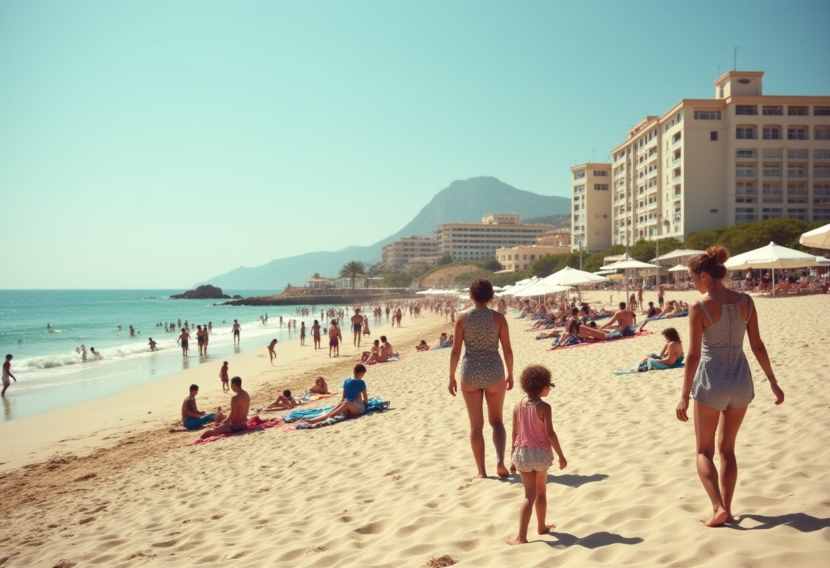≡-Spaniards Locked Out Of Their Own Beaches As Tourism Surge Pushes Prices To New Heights – Viral of Today
<> Viral of Today <>
Home » TOURISM NEWS » Spaniards Locked Out Of Their Own Beaches As Tourism Surge Pushes Prices To New Heights Monday, July 14, 2025For the typical Spaniard, the beach holiday in the home country is a perpetually distant aspiration. As the tourist influx in Spain hits record numbers, the populace is struggling to enjoy the very shores and resorts that attract millions of foreigners yearly. With hotel and rental fees skyrocketing, the quintessential Spanish beach holiday is no longer in the budget for most, and that is inducing annoyance, demonstrations, and even an unprecedented shift in travel patterns.Shattering Tourism RecordsSpain is the globe’s second most visited destination after France, and next year, it will receive a record 100 million foreigners. Foreign tourism in 2024 increased by almost 7.3% alone, and the coastal areas, mostly in the Mediterranean region and the Atlantic, gained popularity as hot spots for foreigners. The increased number of foreigners, though, took an unintended toll on the residents.Skyrocketing Prices Price Out LocalsCosts for visiting Spain’s renowned coasts have gone through the roof in the preceding years. The cost for hotels soared 23% in three years, as registered in the average cost for a hotel room, currently at €136. Due to this, coastal vacations are no longer in the cards for the majority of Spanish households. Beachfront rentals are even costlier, jumping 20.3% in mid-2023. As tracked by price-monitoring firm Tecnitasa, beachfront rentals are largely taken in the first quarter, leaving residents no choice but to look for alternative locations, which are less expensive.Wendy Davila, a 26-year-old from Alicante, grieved: “Prices are exorbitant. The whole coast of Spain is very expensive.” She was compelled to cancel a trip to Cádiz, a south coast provincial capital which she would like to do one day as a couple, because it was getting “too expensive.” They opted for a day trip to Burgos, an inland area known for its Gothic cathedral and resting place of El Cid, which was cheaper. “Now you can’t vacation wherever you want, but wherever you can afford,” she complained, which was a sentiment shared by most Spaniards nostalgic for their summer vacation at the beach as children.Local Tourism Decreasing as International Tourism BoomsThe firm’s analysis in theAtlas shows a cause for concern: local tourists decreased by 800,000 in the top 25 coastal locations in the Mediterranean and Atlantic region in Spain last year, while foreign tourists increased by 1.94 million. The gap between the increased inflow from abroad and the downturn in local tourists can be mainly valued against the escalating cost in coastal tourism, which is well beyond most Spaniards.Foreign tourists stayed an average eight nights in the top Spanish beaches in the previous year, but locals could only afford a fourth of the time and spent a fourth of the money. With each subsequent year, an ever-decreasing percentage of Spaniards can afford their preferred beach holiday.As tourist volumes grow, so does grievance. Increasingly, Spaniards are complaining that they can no longer afford their cities and coasts. The injection of tourists made a local shortage of accommodation even more severe, as local people are forced out of rented housing as properties are sold or are rezoned for short-stay tourist lettings in an effort to exploit the growing numbers of foreign tourists.There have been mass demonstrations in tourist hotspots, notably cities like Barcelona, Mallorca, and the Canary Islands. Residents have resented the impact on their populations of mass-tourism, most notably the rising cost of living and loss of local identity. Residents in some regions have even turned to nontraditional methods, including water guns, to express their annoyance at tourists swarming their towns. The rallies are a symptom of the dilemma between the successful tourist industry in Spain and the misgivings among Spanish people.The Spanish Government’s ResponseIn response to growing displeasure, the Spanish government saw a less crowded, eco-friendly alternative for tourism as an appealing one. The Tourism Minister, Jordi Hereu, saw value in distributing tourist attractions in a less central manner in order to not overcrowd the coasts. “To continue to be world leaders in tourism, we need to decentralise our destinations,” Hereu indicated. Hereu is calling on foreign tourists to explore less-visited Spanish sights in less crowded areas inland.To address these problems, the administration launched an inland regions campaign in June 2024, which urged tourists to visit inland areas in Spain and discover their natural and cultural heritage. The “Rediscover Spain” campaign encourages tourists to visit cities like Burgos, León, and rural areas in Castile and León, which are cheaper alternatives to coastal cities.Shifting the Focus towards Inland TourismAs beach resorts are getting too costly, inland regions are becoming a desirable destination for Spanish holidays. In 2024, a further 1.7 million Spaniards favored inland locations rather than busy beach resorts. As inAtlas describes, inland cities such as El Bosque, about 100 km inland from Cádiz, saw an extra 22% in Spanish tourists in the last year. The inland regions are less expensive in lodging and receive less tourist scrutiny, providing relief for people from busy beaches.Also, the shift in travel behavior is seen in the higher demand for short-term rentals on websites like Airbnb. As not many residents are able to afford hotel accommodation, more and more Spanish residents prefer private vacation rentals or apartments, mostly in regions that are not yet seriously affected by mass tourism, like Andalusia and Castille and León.Impact on Spanish Identity and CultureTo some Spanish, the issue is not purely economics. The arrival of foreign tourists is changing the nature of coastal towns, and a dilution of their cultures is feared. As tourist-lined beaches become crowded, others are concerned that their cherished ways are yielding to international commercialisation. The resultant higher rental cost is, in turn, spurring a shift in social life, as residents are becoming less and less present in their very communities.Maria de la Jara, a Madrid nurse, was typical in the sentiments of most residents when in an interview, she explained, “I would visit my family’s home in Cádiz, but today, when a cruise liner is in port, the population doubles. It’s too much.” Maria, like most, is summering in Madrid, holding back from the masses, but visiting family members after the tourist peak.Conclusion: The Balancing Act for Spain’s FutureWith Spain still being a top destination for foreign tourists, the challenge is balancing the financial benefits from tourism and the livelihoods of the people. The country must bridge the gap between tourists and the people, such that the people of Spain are not sidelined as their coast is made a playground for foreign tourists. Whilst the record number of tourists brought a welcome injection to the economy, in equal proportion, the unprecedented influx has underscored significant failings in the Spanish paradigm of mass tourism. As sustainable tourism is promoted by the administration, only future will determine whether or not an equilibrium can be balanced which secures both the continued prosperity of the Spanish tourist industry as well as the ongoing preservation of methods of living for resident populations.
This information will surprise you!
See also
- Read until the end to discover everything.
- Important information you need to know.
- Interesting facts and helpful tips.
Conclusion
Did you enjoy the news? Keep following us daily!













